What do people typically associate with Japan? For some, it’s the world of anime and manga. Others envision the vibrant streets of Shinjuku and Shibuya. And then there are those picturesque images of Japanese folks donning kimonos at places like Asakusa Temple or Meiji Jingu Shrine.
But when July and August roll around each year and the fireworks festival season kicks in, there’s one word that captures everyone’s imagination: yukata.
Now, you might wonder, what sets a kimono apart from a yukata, given their striking similarities?
Kimono: traditional Japanese costume
History of Kimono
The rich history of the kimono as a quintessential Japanese attire traces its origins back to a period even before the Ancient Grave era, which spanned from 300 to 538 AD. Unfortunately, due to the scarcity of historical records from that era, our knowledge is somewhat limited. However, we do have evidence of early versions of the kimono, characterized by small sleeves and hakama, through paintings found on excavated artifacts.
The term “kimono” itself emerged during the Ancient Cemetery period, a time marked by significant cultural exchanges and trade with the southeastern coast of China. It was during this period that Chinese clothing began to influence Japanese fashion, serving as a precursor to the kimono. Historical accounts suggest that both men and women wore distinct garments during this era.
Japan Pocket Wifi Rental
UNLIMTED DATA SIM CARD
Japan Travel Prepaid SIM card
Moving forward to the Nara period, Japan’s connections with China deepened, leading to substantial influence from the Tang Dynasty on the dressing style of Japanese nobility. This period saw the establishment of formal dress codes, with the kimono closely mirroring the attire of the Tang Dynasty in China. The “Tang costume” style, which would later be worn by nobles, had its roots in this era. However, commoners in Japan continued to prefer simple, practical clothing designed for ease of work.
The Heian period, spanning from 794 to 1185, marked a turning point. With the decline of the Tang Dynasty and the cessation of Tang envoys, Japan experienced a cultural resurgence. During this time, the noble class adopted layered garments and vibrant, colorful clothing as symbols of prestige and authority. It was in this era that the foundations of the twelve-layered kimono, which endures to this day, were laid.

During the transition from the Kamakura period to the Edo period, the traditional Chinese-style “trousers” and “garments” were gradually abandoned, giving rise to significant developments in women’s kimono fashion. The kimono evolved from a combination of separate top and bottom pieces into a one-piece dress. Cuffs tended to become narrower, and the kimono was composed of essential elements such as the okumieri (collar edge), sleeves, and hakama.
The Edo period witnessed a fascinating resurgence of older fashion styles. During this era, historical research led to the revival of ancient dyeing techniques, including the renowned emperor’s yellow robe. Regulations specifying clothing colors and styles based on social ranks were also established. Kimono sleeves lengthened, and the obi, once concealed within the garment, emerged as a visible and prominent feature. This period saw the development of various kimono styles and innovative tying methods. Towards the late Edo period, resource scarcity, primarily due to Japan’s isolationist policies, prompted a shift from silk to cotton and linen kimonos.
With the advent of the Meiji era came increased interactions between Japan and Western nations. In the pursuit of modernization and alignment with foreign customs, the upper-class aristocracy began adopting Western clothing. However, the commoners, constrained by financial limitations and cultural traditions, persisted in wearing Edo-period attire. This divergence in clothing styles led to a distinct divide in Japanese fashion, so pronounced that it even gave birth to a new terminology:
「Wafuku」and「Kimono」
In the early days, the garments worn in Japan were simply referred to as “着物” (kimono), which translates to “things to be worn.” However, during the Meiji era, a period marked by Japan’s modernization and increased interaction with the West, two distinct clothing styles coexisted. This gave rise to the distinction between Western clothing, referred to as “洋服” (yofuku), and traditional Japanese attire, which continued to be called “kimono” but was also termed “和服” (wafuku). The Kanji “洋” denotes things or styles from the West, while Kanji “和” signifies things belonging to Japan.
Interestingly, while the Japanese kanji “和服(wafuku)” is a general term for Japanese clothing in Chinese-speaking regions, most other languages retained the pronunciation “kimono” to refer specifically to Japanese clothing.
Now, returning to our main story. During the Meiji and Taisho eras, female students commonly wore a costume known as the “lantern hakama” for special occasions, a tradition that continues today for entrance and graduation ceremonies. However, by the late Taisho period, the heavy and expensive kimono began to be replaced gradually by lighter and more affordable Western clothing. Additionally, the devastating 1923 Kanto Earthquake highlighted the hazards of wearing kimonos that restricted movement, as a tragic number of women lost their lives due to these impractical garments during the disaster.
Women’s Kimono
Women’s kimonos are categorized in various ways based on their style, color, and pattern. Let’s explore some of the more notable ones.
Furisode(long-sleeved kimono, 振袖)

The most formal attire for unmarried women, it boasts sleeves measuring 100-110cm in length and showcases a vibrant pattern that adorns the entire garment.
Typically, you’ll spot this kimono worn by brides, as well as unmarried female attendees at weddings. It’s also a popular choice for young women participating in the Coming of Age Ceremony when they turn 20 years old.
Kurotomesode(黑留袖)/Irotomesode(色留袖)
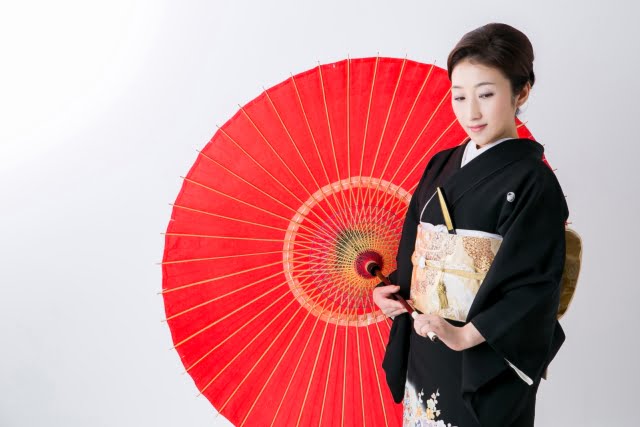
Kurotomesode/Irotomesode(Kuro:black; Iro:colorful)
In contrast to the Furisode, the Kurotomesode (black) and Irotomesode (colorful) are the most formal attire choices for married women. When a Japanese woman gets married, the kimono sleeves are shortened to signify her marital status. Consequently, the Kurotomesode and Irotomesode have much shorter sleeves compared to Furisodes. These kimonos are adorned with floral embroidery on the skirt and cuffs. Kurotomesode is typically worn by the bride’s mother at weddings, while Irotomesode is the preferred choice for married women attending such events.
Houmongi(semi-formal kimono for women, visiting dress,訪問着)
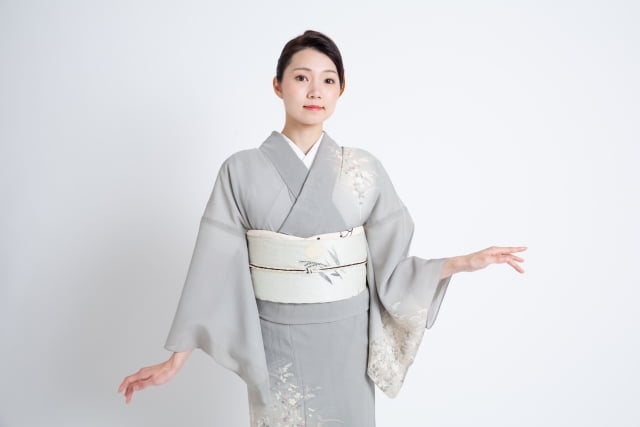
Houmongi is a style of semi-formal kimono that doesn’t differentiate between married and unmarried individuals. It’s known for its intricate thematic designs, often featuring highly ornate patterns that extend from the sleeves to the hem. Houmongi kimonos are typically worn on occasions like weddings (for non-relatives), tea parties, and various social gatherings. However, because they are not the most formal option, they are not suitable for extremely formal events.
Komon(小紋)
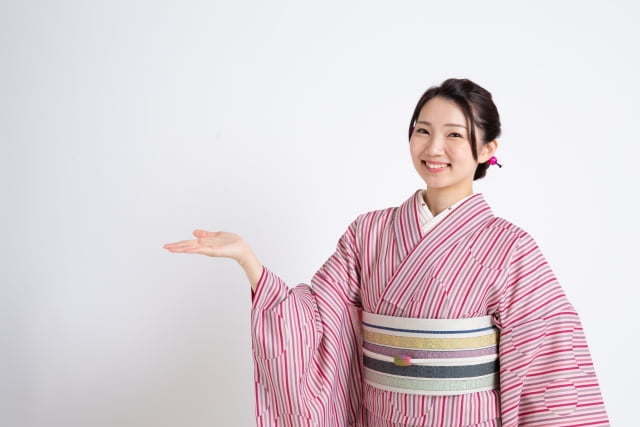
The key distinction between Komon and the previously mentioned kimonos lies in the pattern. In Komon kimonos, the pattern is no longer restricted to a specific area of the garment; instead, it covers the entire kimono with a consistent theme. The patterns in Komon are more akin to textures – they are very small but evenly spread throughout every corner of the garment. Consequently, Komon kimonos are not typically chosen for formal occasions but are instead commonly worn as everyday attire.
Men’s Kimono
Men’s kimonos are generally known for their simplicity compared to the more intricate women’s kimonos. Here are some key differences:
- Color : Men’s kimonos typically come in subdued colors such as black, deep blue, dark green, and brown. These colors are usually plain and non-reflective. However, in modern times, you can also find men’s kimonos in lighter and livelier colors like light purple, light green, and light blue, sometimes with smaller patterns.
- Sleeves : Men’s kimonos feature long sleeves as well, but unlike women’s kimonos where the long sleeves are almost detached from the torso, men’s kimono sleeves are mostly attached to the garment, except for the very end which is left unsewn.
- Sleeve Width : The sleeve width of men’s kimonos is narrower than that of women’s kimonos. This narrower width makes it easier to attach the obi (sash) securely around the waist.
These characteristics contribute to the more understated and functional design of men’s kimonos.
Special Kimono
Jūnihitoe( ’twelve layers’, 十二単)
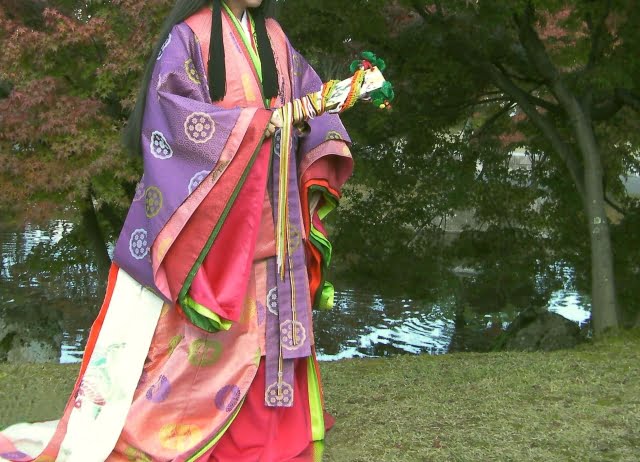
The Jūnihitoe, worn by Japanese noblewomen in the late Heian period, was the most formal and elaborate dress of its time. Its most distinctive feature was the requirement to wear multiple layers of clothing to create a sense of solemnity and grandeur. Typically, the Jūnihitoe consisted of seven layers, worn from the outermost to the innermost, including “itsutsuginu” (a series of layered robes), “karaginu” (a short coat worn over the itsutsuginu), and “mo” (a long, skirt-like train for formal occasions). In its earliest form, it could consist of as many as 18 to 20 layers of clothing. Due to this intricate layering, the official name of the Jūnihitoe was “itsutsuginu-karaginu-mo (五衣唐衣裳)”. The twelve(Jūni) of Jūnihitoe is not a specific designation, but a general reference to the many layers of clothing.
In modern times, the Jūnihitoe continues to be the official attire of Japanese imperial women during significant ceremonies like inaugurations, weddings, Imperial Ceremonies, and festivals. If you watch videos of the Emperor’s inauguration in 2019, you’ll see the Empress, Prince Consort, and Princesses gracefully adorned in distinct twelve-layered Jūnihitoe, showcasing the enduring elegance of this traditional attire.
Shiromuku(white pure-innocence, 白無垢)
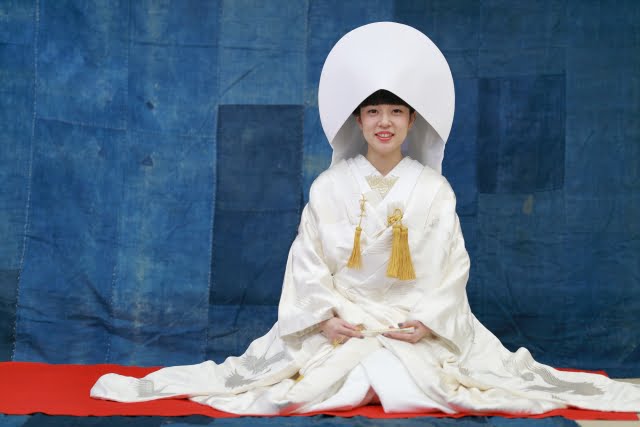
While many people associate Shiromuku primarily with bridal gowns, historically, it had a broader range of uses in various life events. In addition to weddings, Shiromuku was worn during births, funerals, and even by individuals performing harakiri (a form of ritual suicide). This is because white holds deep cultural significance in Japan, representing purity, sacredness, and the sun.
However, after the Meiji era, Shiromuku became primarily associated with brides and was worn exclusively at shrine weddings. It is distinguished not only by its pure white exterior but also by its white interior, including the underwear, obi (sash), decorations, and straw footwear. This all-white ensemble symbolizes the bride’s commitment to “taking on the color of her husband from now on” and signifies purity and cleanliness in this significant life transition.
What is a Yukata?
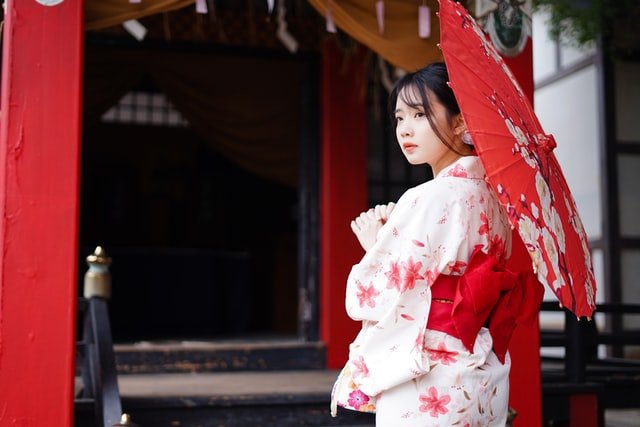
History of Yukata
Yukata, in their earliest form, served as simple garments to be worn before and after bathing. Consequently, they were crafted from materials with better absorbent qualities and were commonly worn after soaking in a hot spring. In the Showa era, they also evolved into a type of sleepwear or pajamas. This historical context made it somewhat embarrassing to wear a yukata out in public during daylight hours.
However, as time went on, yukata gained popularity, and their use expanded beyond post-bath or bedtime attire. Today, one of the most common occasions to see people wearing yukata in modern Japan is during the annual fireworks festivals in the summer. Men and women don various styles of yukata to enjoy the mesmerizing displays. Additionally, many hot spring inns provide yukata free of charge to their guests, further enhancing their appeal. Due to their lightweight and sweat-absorbing properties, it’s not uncommon for Japanese people to wear yukata when attending sports events, concerts, or visiting amusement parks.
Accessories for Yukata
Yukata is the simplest type of kimono, making it an ideal starting point for teaching Japanese tailoring in schools. Consequently, the accessories for yukata are also relatively uncomplicated. Alongside the yukata itself, you typically find an obi, which serves to secure the yukata, and a pair of Japanese wooden clogs.
As yukata is typically worn during the hot summer months, it’s customary not to wear socks with the clogs.
Additionally, the process of tying the obi for women’s yukata is considerably more intricate than that for men’s yukata. Many modern individuals find it challenging to tie it themselves. This has given rise to the “Tsukuriobi,” a pre-tied and pre-shaped belt that eliminates the need for self-tying.
Difference between kimono and yukata
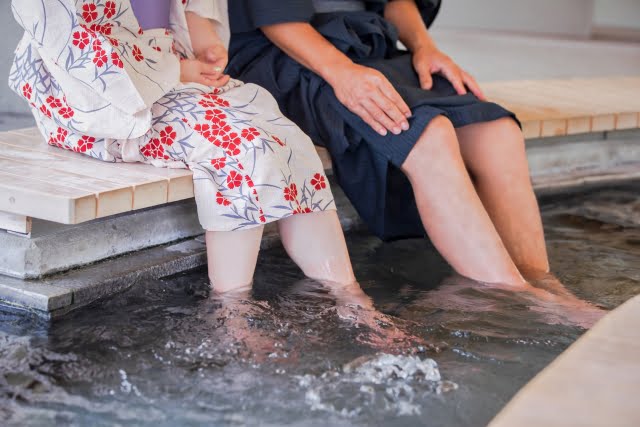
Season
Yukata: Basically for wearing in summer
Kimono: There are types that are thicker and suitable for wearing in winter, and types that can be worn in summer with just one piece. Compared to yukata, kimono can be worn all year round.
Fabrics
Yukata: More breathable fabric, such as cotton and linen, polyester, so the price is cheap.
Kimono: Usually silk. The price is expensive.
Wearing occasion
Yukata: For bathing in hot springs, fireworks, concerts, and large competitions, and also for everyday wear.
Kimono: Depending on the form, there are different occasions to wear it, but it is usually worn for more formal occasions. In recent years, there are also kimonos for everyday wear.
Sleeve length
Yukata: Usually around 50cm, not too long.
Kimono: The length of the sleeves varies, with the longest vibrating sleeves reaching 110cm and dropping directly to the ground.
Accessories
Yukata: simpler, only obi and clogs, and the obi is more casual, even the obi is already tied and shaped.
Kimono: more, the obi has all kinds of decorations and is very complicated to tie up; when you wear straw footwear, you also have to wear footbags (special socks), and sometimes you also have to match the Haori (kimono jacket)
Japan Pocket Wifi Rental
UNLIMTED DATA SIM CARD
Japan Travel Prepaid SIM card
